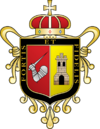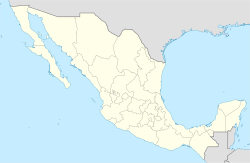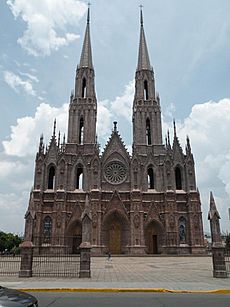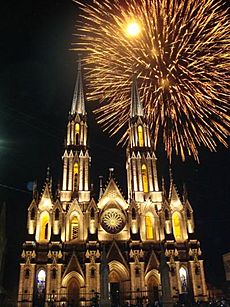Zamora, Michoacán facts for kids
Quick facts for kids
Zamora de Hidalgo, Michoacán
Zamarat
|
||
|---|---|---|
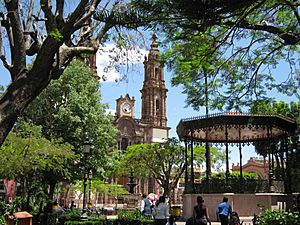
Plaza de Armas of Zamora
|
||
|
||
| Motto(s):
Cradle of Illustrious Men
|
||
| Country | Mexico | |
| State | Michoacán | |
| Foundation | 18 January 1574 | |
| Founded by | Martín Enríquez de Almanza | |
| Named for | Zamora, Spain | |
| Elevation | 1,580 m (5,184 ft) | |
| Population
(2020)
|
||
| • City | 186,102 | |
| • Metro | 273,641 | |
| Time zone | UTC-6 (Central Standard Time) | |
| • Summer (DST) | UTC-5 (Central Daylight Time) | |
| Zip code |
59600–59725
|
|
| Website | http://www.zamora.gob.mx | |
Zamora de Hidalgo is a city in the Mexican state of Michoacán. It's the third largest city in the state. The city is the main town of the Zamora Municipality. This area also includes many smaller towns. The municipality is the second most populated urban area in Michoacán.
Zamora is an important economic hub in the state. It's a key city between Morelia and Guadalajara. The city sits on the Tarascan Plateau in the northwestern part of Michoacán. It is about 1,567 meters (5,141 feet) above sea level. Zamora is surrounded by the very fertile Tziróndaro Valley. This valley is a big farming area that sends lots of fresh produce to the United States.
Contents
Why is Zamora de Hidalgo Called That?
The city got its name from Zamora, a city in Spain. This is because the first European settlers here came mostly from the Spanish province of Castilla y León. The name Zamora comes from an old word meaning "The Walled City." This is because it is surrounded by high hills.
In 1953, the city officially added "de Hidalgo" to its name. This was to honor Miguel Hidalgo y Costilla. He was a leader in Mexico's fight for independence. He declared Zamora a city during this important time.
A Look at Zamora's History
People first lived in the Zamora area around 1500 BC. Before Europeans arrived, different tribes moved into the area. These included the Pirinda, Nahua, Huetamo, Colima, and Purépecha tribes. The name Tziróndaro Valley, where Zamora is located, means "swamp place" in the Purépecha language.
The village of Zamora was started on January 18, 1574. This happened by order of Viceroy Martín Enríquez de Almanza. Spanish settlers from the city of Zamora in Spain founded it. The Spanish liked the area because its fertile valleys were great for farming.
Zamora became an official city in 1825. This confirmed a decision made earlier by Miguel Hidalgo y Costilla in 1810. During the 1800s, Zamora grew into a major cultural and economic center. This was thanks to its strong farming and busy trade. On December 10, 1831, Zamora was named the main town of its municipality.
Later, some important people in the city wanted Zamora to be the capital of a new state. In 1846, Archbishop Pelagio Antonio de Labastida y Dávalos began a religious separation from Mexico City. By 1862, a new church office, the Dioceses of Zamora, was set up in the city. However, the plan for Zamora to become a state capital did not happen.
Growth and Modernization (1854-1910)
During a time known as the Porfiriato, Zamora saw its fastest economic growth ever. Between 1854 and 1910, the city grew quickly. This was due to new industries, city improvements, new technologies, and better farming. Zamora was one of the first cities in the state to get new technologies. These included railroad stations, telegraphs, telephones, electricity, and modern water systems.
In 1899, a railroad connected Zamora to other important cities in central Mexico. At the same time, city planners wanted to modernize Zamora. Many new building projects took place. During this period, Zamora saw a rebirth in architecture. Many popular European styles were used. Large government buildings and churches were built. They showed off the city's wealth. Examples include the Michoacán Center for the Arts and the Obrero de Zamora Theatre.
On February 2, 1898, the first stone was laid for the Cathedral of Our Lady of Guadalupe. This was led by the second bishop of Zamora. Many wealthy families built new homes. These homes were inspired by Victorian and Châteauesque styles.
Revolution and Later Years
The Mexican Revolution reached Michoacán in 1911. People loyal to Francisco I. Madero claimed Zamora and the surrounding area. The city remained involved in the war even after the state governor resigned. In 1918, the state approved its constitution.
After the Mexican Revolution, the Cristero War continued to harm farming in the region. This had bad economic effects on the city. Political fighting finally ended in Zamora and nearby areas in 1926.
Zamora's Geography and Climate
Zamora de Hidalgo is in the northwestern part of the state of Michoacán. It is on the Tarascan Plateau. The city is about 1,567 meters (5,141 feet) above sea level. It is the main town of the Zamora Municipality. This area covers about 330.97 square kilometers (127.79 sq mi). It includes many smaller communities. The largest of these is Ario de Rayón.
The city is located in the Tziróndaro Valley. This valley is a large flat area surrounded by mountains. The land here is mostly flat. In the past, this area was a flood plain of the Duero River. This caused rich soil to be deposited. The soils in the surrounding areas are very fertile. This makes the region excellent for farming.
Zamora's Climate
Zamora has a humid subtropical climate. This means it has warm, wet summers and mild, drier winters. The average yearly temperature is about 18.5 °C (65 °F). May is usually the warmest month, with an average temperature of 23.3 °C (74 °F). December is the coldest, with an average of 14.7 °C (59 °F). The city gets about 900.6 mm (35.4 inches) of rain each year. Most of this rain falls during the summer months.
| Climate data for Zamora de Hidalgo, Michoacán | |||||||||||||
|---|---|---|---|---|---|---|---|---|---|---|---|---|---|
| Month | Jan | Feb | Mar | Apr | May | Jun | Jul | Aug | Sep | Oct | Nov | Dec | Year |
| Record high °C (°F) | 34.1 (93.4) |
35.8 (96.4) |
38.4 (101.1) |
39.0 (102.2) |
48.1 (118.6) |
40.2 (104.4) |
37.0 (98.6) |
38.0 (100.4) |
37.9 (100.2) |
37.8 (100.0) |
36.0 (96.8) |
35.3 (95.5) |
48.1 (118.6) |
| Mean daily maximum °C (°F) | 27.4 (81.3) |
29.2 (84.6) |
31.6 (88.9) |
33.4 (92.1) |
34.3 (93.7) |
32.1 (89.8) |
29.6 (85.3) |
29.7 (85.5) |
29.7 (85.5) |
29.6 (85.3) |
29.1 (84.4) |
27.5 (81.5) |
30.3 (86.5) |
| Daily mean °C (°F) | 17.5 (63.5) |
19.0 (66.2) |
21.4 (70.5) |
23.4 (74.1) |
24.9 (76.8) |
24.3 (75.7) |
22.7 (72.9) |
22.6 (72.7) |
22.5 (72.5) |
21.3 (70.3) |
19.8 (67.6) |
18.2 (64.8) |
21.5 (70.7) |
| Mean daily minimum °C (°F) | 7.7 (45.9) |
8.8 (47.8) |
11.1 (52.0) |
13.4 (56.1) |
15.5 (59.9) |
16.5 (61.7) |
15.7 (60.3) |
15.6 (60.1) |
15.2 (59.4) |
13.0 (55.4) |
10.5 (50.9) |
8.9 (48.0) |
12.7 (54.9) |
| Record low °C (°F) | −3.0 (26.6) |
−1.0 (30.2) |
3.0 (37.4) |
6.0 (42.8) |
8.0 (46.4) |
5.8 (42.4) |
0.0 (32.0) |
6.2 (43.2) |
9.8 (49.6) |
6.5 (43.7) |
2.0 (35.6) |
0.2 (32.4) |
−3.0 (26.6) |
| Average precipitation mm (inches) | 15.9 (0.63) |
4.6 (0.18) |
5.6 (0.22) |
13.0 (0.51) |
40.7 (1.60) |
150.2 (5.91) |
213.6 (8.41) |
175.4 (6.91) |
153.7 (6.05) |
52.1 (2.05) |
15.8 (0.62) |
16.7 (0.66) |
857.3 (33.75) |
| Average precipitation days (≥ 0.1 mm) | 1.9 | 1.4 | 1.4 | 2.3 | 5.6 | 16.2 | 21.4 | 20.8 | 15.3 | 6.8 | 2.0 | 2.8 | 97.9 |
| Average relative humidity (%) | 55 | 52 | 49 | 47 | 49 | 64 | 72 | 71 | 70 | 64 | 61 | 58 | 59 |
| Mean monthly sunshine hours | 235 | 227 | 246 | 236 | 239 | 188 | 163 | 198 | 171 | 211 | 233 | 223 | 2,570 |
| Source 1: Servicio Meteorológico Nacional | |||||||||||||
| Source 2: Deutscher Wetterdienst (sun, 1961–1990) | |||||||||||||
Learning in Zamora: Universities
Zamora has several places for higher education. These are like colleges and universities where you can study after high school. Here are some of them:
- Centro de Estudios Universitarios Veracruz “Univer”
- Instituto Tecnológico de Estudios Superiores de Zamora
- Universidad de Zamora
- Universidad del Valle de Atemajac
- UPN Unidad 162 Zamora
- Colegio de Michoacán
- UMSNH Facultad de Medicina "Dr. Ignacio Chavez" Extension Zamora
Fun Things to See and Do in Zamora
The city center of Zamora has many old, historic buildings. These were built during the time of Spanish rule or in the 1800s. Some of these cool places include:
- The Temple of San Francisco
- The Cathedral of Our Lady of Guadalupe (which is the tallest cathedral in Mexico!)
- The church of San Francisco
- The church of El Calvario
- The Morelos Market
- The Federal Palace
One of the most popular places to visit is the Cathedral of Our Lady of Guadalupe. It is on 5 de Mayo Avenue. This cathedral is built in a Neo-Gothic style. Its construction started on February 2, 1898. It is very tall, reaching 107.5 meters (352.69 feet) high. It is also 95 meters (311.67 feet) long and 57 meters (187 feet) wide. Its total area is 5,415 square meters (58,286.57 sq. ft.). This makes it one of the largest cathedrals of its kind in North and South America! There is also the Cathedral of the Immaculate Conception.
Zamora offers many fun activities. The Theater of the City of Zamora often has events like piano concerts, plays, and chamber music. The School of Michoacán A.C. in Zamora also hosts cultural events. These include film festivals, concerts, and traditional folk dances.
Every December, Zamora holds the Festival of the Chongos zamoranos. This is a chance to try local foods, enjoy music and dances. There is also a "Poets Meeting." On December 12, special events happen at the Cathedral of Our Lady of Guadalupe and around the city. A great nearby place to visit is the Lago de Camécuaro National Park. It is one of Mexico's national parks.
Famous People from Zamora
Many notable people have come from Zamora. Here are a few:
Politics and Diplomacy
- José Sixto Verduzco: A leader during the Mexican War of Independence. He also served as a senator for Michoacán.
- Alfonso García Robles: He won the Nobel Peace Prize in 1982. He was also Mexico's Secretary of Foreign Affairs.
- Marta Sahagún: The wife of former Mexican president Vicente Fox.
Arts and Culture
- Eduardo del Río: A famous writer and cartoonist.
Sports
- Rafael Márquez: A well-known football (soccer) player for Atlas F.C. and FC Barcelona.
- Ricardo Rodriguez: A former WWE wrestler. He was also the personal ring announcer for Alberto Del Rio. His family is from Zamora.
- Juan Carlos Chavez: A former football (soccer) player.
- Luis Ángel Landín: A football (soccer) player for Municipal Pérez Zeledón.
See also
 In Spanish: Zamora de Hidalgo para niños
In Spanish: Zamora de Hidalgo para niños


